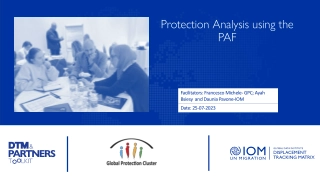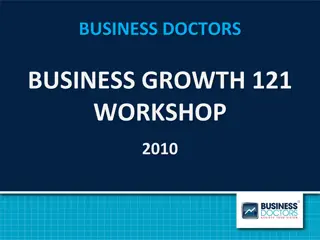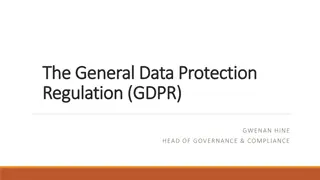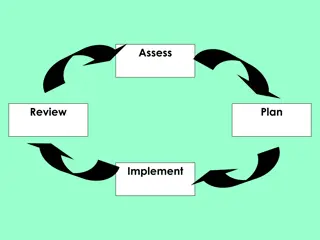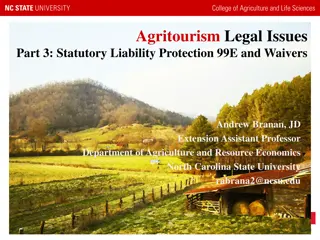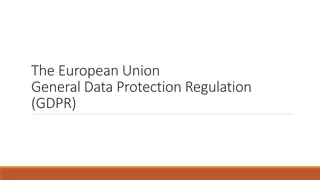Safeguard Your Business: Essential Protection Strategies Revealed
Unveil the comprehensive protection strategies for your business with Financial Fortress Ltd.'s webinar. Explore shareholder and partnership protection, group death in service, key person cover, and relevant life planning to fortify your business against unforeseen risks. Founded in 2014, Financial Fortress is committed to empowering businesses with vital financial security measures.
Download Presentation

Please find below an Image/Link to download the presentation.
The content on the website is provided AS IS for your information and personal use only. It may not be sold, licensed, or shared on other websites without obtaining consent from the author. Download presentation by click this link. If you encounter any issues during the download, it is possible that the publisher has removed the file from their server.
E N D
Presentation Transcript
Webinar Overview Introduction Share holder (& Partnership) protection Group death in service Key Person Cover Relevant Life Planning Summary Questions
Financial Fortress ltd Founded in 2014, Financial Fortress believes that great financial planning is absolutely key to everyone at all stages of their lives to ensure total financial security, protect your loved ones and allow absolute peace of mind. Our team is made of 9 experts including 6 advisers that are dedicated to providing a 5-star service to all their clients.
Shareholder Protection What is it? A cost-effective way for business owners to secure their succession plans ensuring future business ownership ends up in the right hands should an owner or shareholder die.
Why is Shareholder Protection planning so important? When someone dies, their property (including company shares or proceeds from a partnership) becomes the property of the deceased s estate . This passes the assets, control & profits of the business away from the original owners! Think! 1. How would you feel paying profits forever to your ex-partners family, especially where they are not contributing to the running of the business? 2. How would you feel, your ex-partners family wanting to get involved in running the business and making decisions in a business they may not understand?
So how is Shareholder Protection set up? Each owner (partner/shareholder) effects a life insurance policy on their own lives for an amount equal to their share value Placing each policy into a trust , in benefit for the fellow business owners The future deal is underpinned by a cross option agreement You should also equalise the premiums , meaning each shareholder/partner pays an equivalent share of the cost, given the share they will ultimately receive.
In the event of either death, the following happens: The deceased s estate continues to inherit the shares of the business However, the remaining shareholders receive the proceeds from the life policy The cross-option agreement can be exercised by either side and when exercised becomes binding on the other party. Meaning the cash passes to the beneficiaries of the shares in return for the shares passing to the remaining business owners
Key facts and benefits: No tax relief on premiums, where company pays charged to P11D Policy pays out tax-free No tax to the beneficiaries (income/CGT/Inheritance tax etc) Rapid pay-out on death Flexible beneficiaries Needs regular review for business valuation purposes
Group death in service A cost-effective way for an employer to provide some life cover to either selected groups of, or all employees. Defined and regarded as a perk for staff.
Why is Group death in service important? Providing death in service benefits can go a long way towards demonstrating an employers genuine welfare for staff, fostering loyalty and reassurance that you care! If (and we hope not!) an employee dies, a cash sum will be available to the employer, to provide the deceased s family with a lump sum or possibly income for a period of time.
So, how is Group Life set up? Arranged on a group basis (minimum 5 staff). Employees are the lives assured but there is no individual underwriting Employer pays premiums (eligible for tax relief) Usually covers a multiple of income, ie: 4 x income (subject to a maximum of 10x) Policy is written in trust (usually for the employer) Usually agreed and renewed annually
Key facts and benefits: Company gets tax relief on the premiums No tax on policy proceeds (including inheritance tax) No P11D implications (no income tax/national insurance on premium or sum assured) No implications on pensions funding or lifetime allowance Immediate payment on death Flexible beneficiaries
Any Questions about Group death in service?
Key Person Cover A cost-effective way for an employer to ensure that, on the death or critical illness of a key employee, the employer or business receives a sum of money to reduce the impact of the employee not being able to complete their role. Can be used to cover Directors or key staff such as Sales Managers etc.
When and why is it used? Protect profits: Recruitment costs ( use multiple of salary ) Loss of profits (use multiple of profits ) Pay penalties for non-delivery or late delivery of goods Pay company sick-pay to the key-person (critical illness only) Pay debts: Repay loans/debts Nervous suppliers demanding payment up front Owed salaries, dividends or directors loan accounts
So, how is Keyperson cover setup? A life insurance policy is effected on one of the following basis: Own life in trust (by the employee) or Life of another (by the company) basis. Key-person is the life assured Employer pays premiums On death (or critical illness), the company is paid the sum assured quickly to maintain profitability, meet recruitment costs and ensure business continuity!
Key facts and benefits: Tax relief on premiums may be available (where 5 years or less, no conversion option) However, when sum assured received, treated as a trading receipt unless treated as a capital value for tax purposes (with loss of the relief already given on premiums).
Anderson rules (tax relief detail) Insurance can only be for employers on the lives of an employee Sole relationship is of employee/er. Ie: if 5%+ shareholding then not Intended to meet loss of profit Annual or short term (less than 5 years, none convertible)
Relevant Life Protection A cost-effective way for an employer to provide life cover to an employee. In other words, benefits will be paid to the employee s family only. (No lump- sum benefit to the business). Directors and employees can be provided with their PERSONAL life cover needs! Premiums also receive corporation tax relief. Whereas, paying premium themselves is from net pay (after tax and NI).
So, how is Relevant Life set up? Each employee/Director effects a specialist life insurance policy Employee is the life assured Employer pays premiums (eligible as a legitimate expense) Policy is written in trust (to control death benefits) Max age 75, multiple of earnings limits On death, the employees family receives the proceeds.
Key facts and benefits: Company gets tax relief on the premiums No tax on policy proceeds (including income tax, NI or inheritance tax) No P11D implications (no income tax/national insurance on premium or sum assured) No implications on pensions funding or lifetime allowance Rapid pay-out on death Flexible beneficiaries
Tax the complex bit! Lets base this on spending 1,000 per year on life insurance! (HRT) Employees NI at 2% Income tax at 40% Employers NI at 13.8% Total gross cost Ordinary cover 34 690 238 1,962 Relevant Life Plan Nil Nil Nil 1,000 Tax relief to the company Net cost - 373 1,570 - 190 810 (Corp tax) ( 760 per year)
When usually used: Business owners personal life cover (Directors/shareholders etc) Key employees as an additional staff benefit
To Summarise Thinking about your business s protection needs is vital, just as planning for any unforeseen event would be. Money is the last thing you would want to worry about in the event. Purchasing life insurance through a business can be extremely tax efficient. Personal life policies can also be put on expenses ! If you fail to plan . you are planning to fail!
Thank you all for your time! We hope you found the webinar relevant and interesting! For further advice feel free to contact us for a no-cost and no obligation chat! Phone us on 01244 319962 Email us on info@financialfortress.co.uk Go to our website - www.financialfortress.co.uk

















